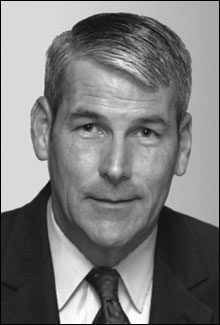
CHANGE AT THE TOP Brady
faces high expectations in succeeding Evans,
but improving the schools requires support
from the wider community. |
For someone who has been squeezed through the wringer of Providence politics, Donnie Evans, the city’s outgoing school superintendent, offers a very chipper assessment of the out-look for Rhode Island’s largest — and most consequential — school system.
“I think the district has made tremendous progress” during his three-year tenure, Evans says, particularly with a 10 percent increase in reading proficiency, as measured in standardized testing, among elementary and middle school students.
The superintendent points to a shift in the organizational culture of public education in Providence, a place where, as he notes with more than a bit of understatement, students have not always been placed first. Evans acknowledges the presence of some troubled schools, but says that many more are first-rate than widely recognized. Touting a city-state effort to accelerate progress over the next few years, he adds, “I think people are going to be very pleasantly surprised.”
The superintendent, who continues to hunt for a new job, has reason to put the best face on his time here. Yet even one of the most tangible accomplishments that he cites — the 10-point gain in reading proficiency for elementary and middle school students — underscores the depth of the problems in Providence. Although the increase seems signifi-cant, it raised the level of proficiency to just about 40 percent of those students — hardly an indicator of a successful educational system.
And while Evans’s three-year tenure is roughly the norm for a superintendent in an urban district, it also points to the unsettled nature of the top job in the Providence. Going back to the arrival of Diana Lam in the late ’90s, a series of well-compensated leaders have arrived amid acclaim and hopes of stability and long-term gains, only to depart after a few years.
In Evans’s case, his fate crumbled after the infamous December 13 snow storm, when he was unaware into the evening of how young students remained on school buses, long after they were supposed to have been transported home. (He declined comment on the reasons for his departure, other than to say that he found himself spending too much time defending himself and the district, rather than focusing on the core responsibilities of his job.)
Befitting the messiah-like way in which new superintendents are expected to single-handedly solve the complex and deep-rooted problems of urban education, Tom Brady, the former military man stepping in to replace Evans in September, happens to share a name with the superstar quarterback of the New England Patriots.
Yet delivering serious improvement in the Providence schools will obviously not be a quick fix.
If a number of Providence’s schools are indeed better than the stereotypical view from the suburbs, the cause of reform nonetheless faces immense hurdles. This is due both to the outside factors that wield a seriously disproportionate impact in the capital city — poverty, transient families, the presence of a lot of new immigrants, and so on — and the issues particular to Providence and the change-averse culture of the city’s schools.
Going forward, as Rhode Island continues to struggle with budget deficits and economic development, the future of education in Providence is another piece of the same puzzle. While some view the city and its under-resourced schools as a money pit, the workforce emerging from the state’s cities is highly unlikely to have good prospects without some broad improvement.
A rude awakening
Bert Crenca, the streetwise artistic director of AS220, the nonprofit downtown Providence arts space, describes himself as Mr. Idealist. Yet three years of service on the Providence School Board left Crenca boggled by the immensity of the difficulties facing the city’s schools. “It was all somewhat of a rude awakening for me,” Crenca says, and he concluded he wasn’t tough enough to continue serving on the board.
“The awesomeness of the challenge was even more than I anticipated,” he says, in a district with more than 50 schools; more than 25,000 students; a very transient population, even within Providence; archaic school buildings; an archaic educational system; and a handful of different bargaining units. Rhode Island also remains dependent on the property tax to fund public education, a situation, critics say, that leaves urban schools with insufficient resources.
In another sign of the dismal performance of these districts, the state Department of Education last week dropped its estimate of the statewide graduation rate — to 70 percent, from 89 percent — and the figure is close to 50 percent for some high schools in Providence, Pawtucket, and elsewhere.
Crenca and other observers detect a few positive developments, including more rigorous statewide educational requirements and training for new school board members through the Broad Institute, a prominent education reform group.
But, he notes, “as a nation and as an urban district, we are still learning what it means to engage this generation of young people,” who mature faster and are exposed to a lot more stuff than past generations.